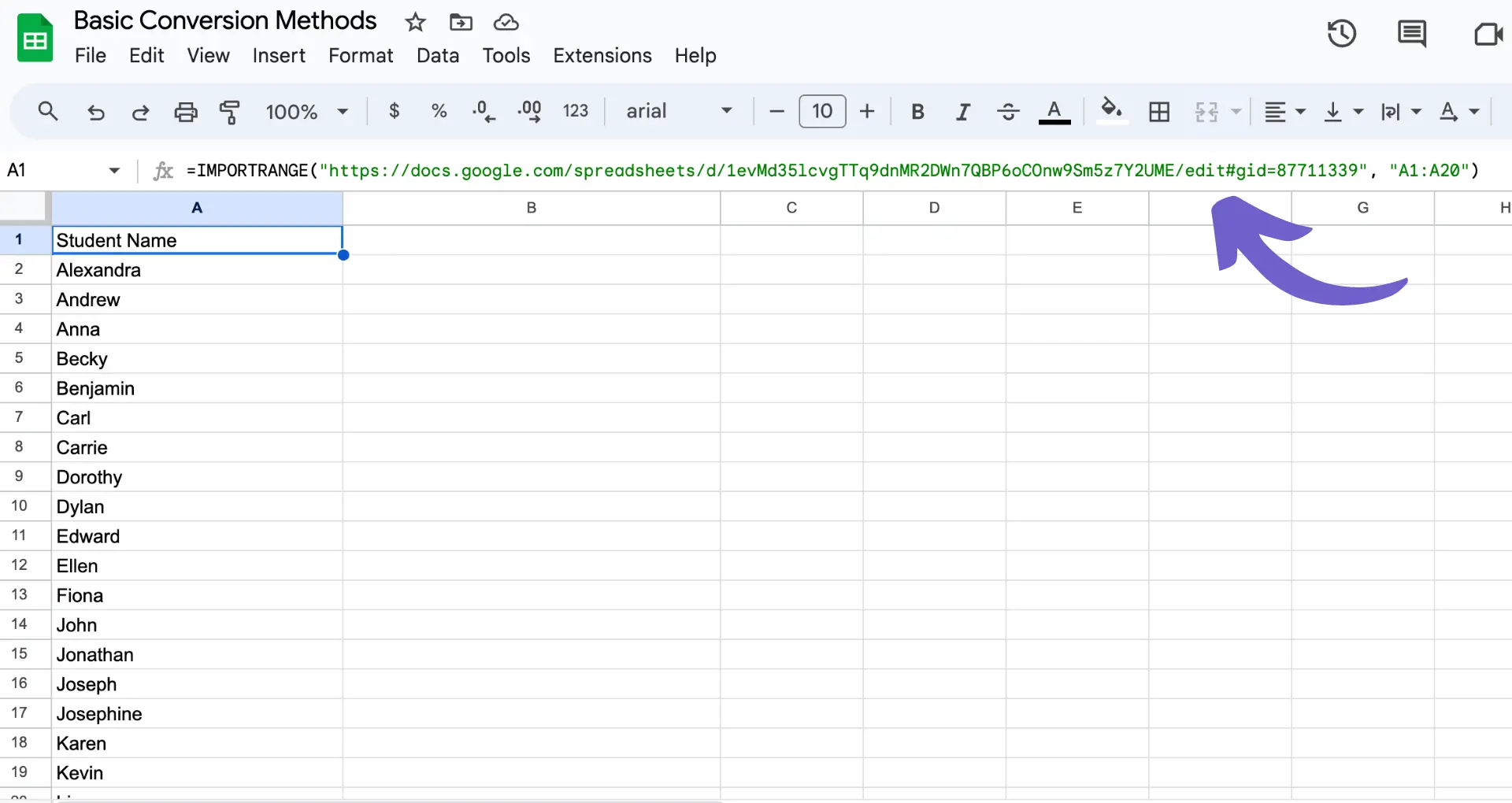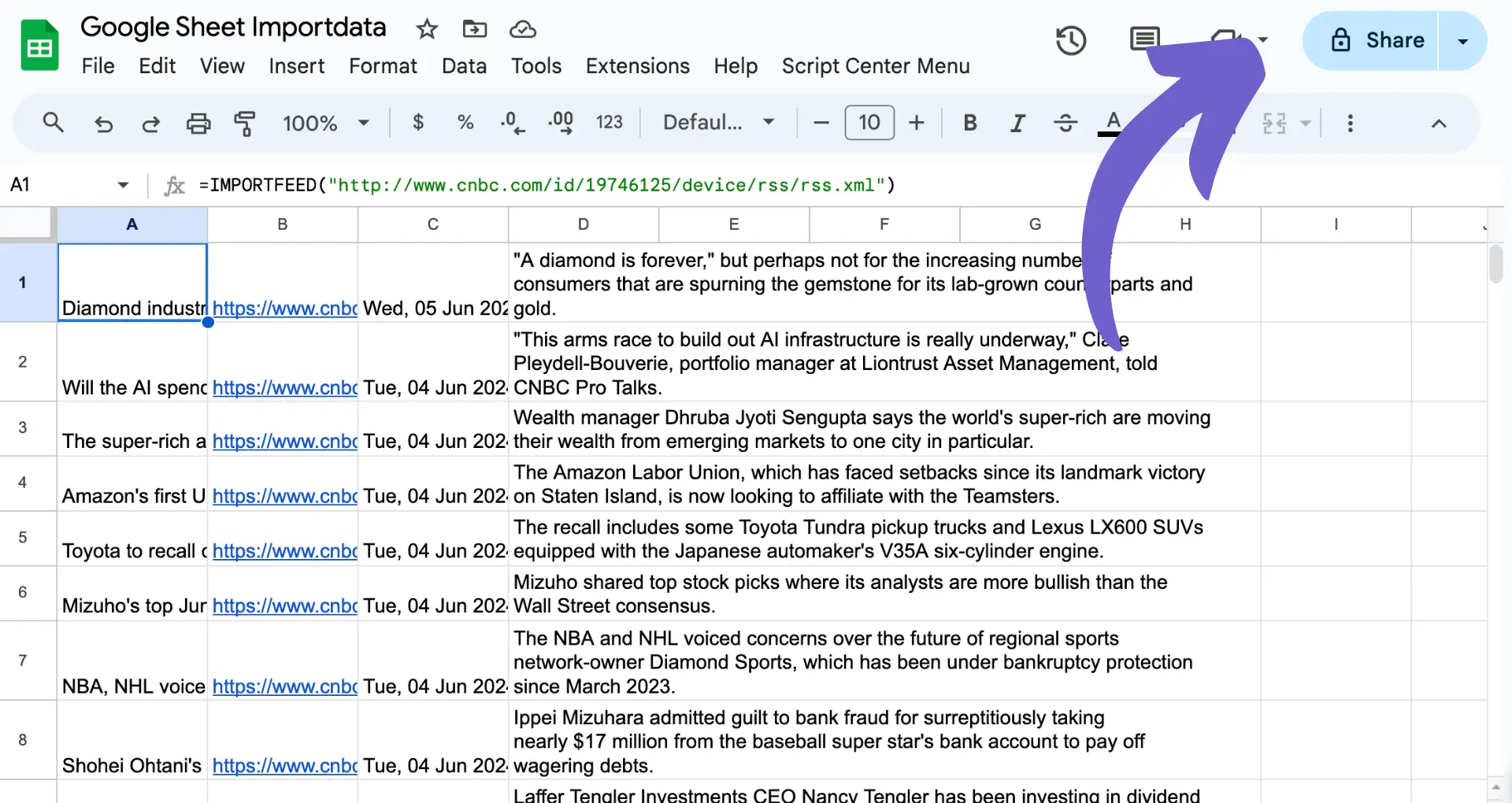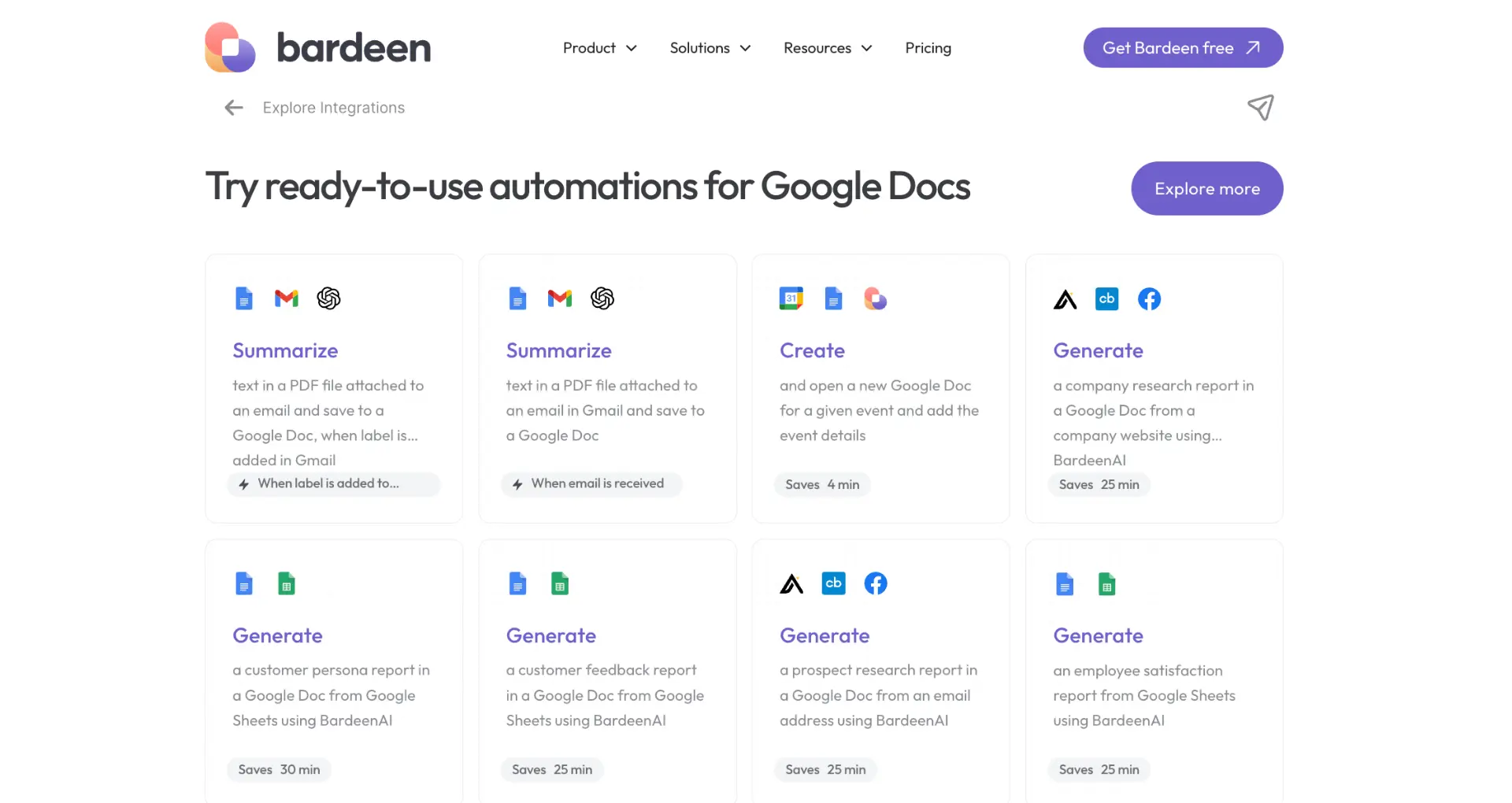Use IMPORTRANGE to import data between Google Sheets in four steps.
By the way, we're Bardeen, we build a free AI Agent for doing repetitive tasks.
If you're importing data, you might love our GPT in Spreadsheets feature. It automates data handling, making your work easier and faster.
IMPORTRANGE is a powerful function in Google Sheets that allows you to efficiently transfer data between different spreadsheets. In this comprehensive guide, we'll walk you through the basics of IMPORTRANGE, from understanding its syntax to setting up your sheets for seamless data import. By the end of this article, you'll be equipped with the knowledge and best practices to make the most of this essential Google Sheets function.
Understanding the Basics of IMPORTRANGE
IMPORTRANGE is a function in Google Sheets that allows you to import data from one spreadsheet to another. It's a powerful tool for combining data from multiple sources and automating data updates. The syntax for using IMPORTRANGE is straightforward:
IMPORTRANGE("spreadsheet_url", "range_string")

- "spreadsheet_url" is the URL of the source spreadsheet, enclosed in quotation marks or referenced from a cell containing the URL.
- "range_string" specifies the range of cells to import, in the format "sheet_name!range" (e.g., "Sheet1!A1:C10"). If no sheet name is provided, IMPORTRANGE will import from the first sheet by default.
For example, to import data from cells A1 to C10 in Sheet1 of a spreadsheet with the URL "https://docs.google.com/spreadsheets/d/abc123", you would use the following formula:
IMPORTRANGE("https://docs.google.com/spreadsheets/d/abc123", "Sheet1!A1:C10")
By mastering the basics of IMPORTRANGE, you'll be well on your way to efficiently managing data across multiple Google Sheets. For more advanced features, you can bring AI into your spreadsheet and streamline your workflows.

Setting Up Your Google Sheets for IMPORTRANGE
Before you can use IMPORTRANGE to import data from one Google Sheet to another, it's crucial to ensure that the necessary access permissions are in place. Here's how to prepare your spreadsheets for data import:
- Open the source Google Sheet (the one containing the data you want to import).
- Click the "Share" button in the upper right corner.
- Enter the email address of the account you'll be using to access the data in the destination sheet.
- Set the access level to "Editor" to ensure the destination sheet can pull data from the source.
- Click "Send" to grant access.

Next, prepare the destination sheet:
- Open the destination Google Sheet (where you want to import the data).
- Ensure that you're using the same account that was granted access to the source sheet.
- Decide where you want the imported data to appear and make sure there's enough space for the data range you'll be importing.
By setting up the proper access permissions and preparing your sheets, you'll be ready to connect Google Sheets and efficiently transfer data between them.
Bardeen can enrich LinkedIn profile information in Google Sheets, making your work smoother and saving time. Try it now!
Step-by-Step Guide to Using IMPORTRANGE
Using the IMPORTRANGE function is straightforward once you understand the syntax and have the necessary permissions in place. Follow these steps to use IMPORTRANGE effectively:
- Open your destination Google Sheet where you want to import the data.
- Click on the cell where you want the imported data to appear.
- Type "=IMPORTRANGE(" to begin the function.
- Inside the parentheses, enter the URL of the source spreadsheet enclosed in quotation marks, followed by a comma.
- After the comma, enter the range of cells you want to import, also enclosed in quotation marks (e.g., "Sheet1!A1:B10").
- Close the parentheses and press Enter.
Your formula should look similar to this: =IMPORTRANGE("https://docs.google.com/spreadsheets/d/abc123", "Sheet1!A1:B10")
If this is the first time you're importing data between these two sheets, a #REF! error will appear. Click "Allow access" to grant permission and the data will load.
Troubleshooting tips:
- Make sure the syntax is correct, including proper quotation marks and commas.
- Ensure you have the necessary permissions to access the source spreadsheet.
- If you encounter a #REF! error, double-check that you've allowed access between the sheets.

Once set up, the imported data will automatically update whenever changes are made in the source spreadsheet, saving you time and effort in keeping your data synchronized. For more advanced automation, consider using Bardeen's AI web scraper.
Handling Common Errors and Issues in IMPORTRANGE
When working with the IMPORTRANGE function, you may encounter various errors that can disrupt your data imports. Here are the most common errors and how to resolve them:
#ERROR! Formula Parse Error
This error occurs when there is a syntax issue in your IMPORTRANGE formula. To fix it:
- Double-check the formula syntax, ensuring proper use of quotation marks, commas, and parentheses.
- Verify the accuracy of the source spreadsheet URL and the range string.
#REF! Permission Error or "You don't have permissions to access that sheet"
This error appears when you lack the necessary permissions to access the source spreadsheet. To resolve it:
- Ensure the source spreadsheet is properly shared with you or set to "Anyone with the link" access.
- If you own the source spreadsheet, double-check that you've granted access to the account running the IMPORTRANGE formula.
Troubleshooting Data Update Issues
If your imported data isn't updating as expected:
- Confirm that the source data has actually changed. IMPORTRANGE won't refresh if there are no changes.
- Check for any changes in the source spreadsheet's structure, such as renamed sheets or modified range references.
- Verify that your IMPORTRANGE formula is still valid and hasn't been accidentally modified or overwritten. For more efficient data management, consider using data enrichment tools.
Bardeen can help you connect Google Docs and simplify your spreadsheet workflows. Try it for easier and faster data management.

By understanding and addressing these common errors, you can ensure a smooth and reliable data import process using IMPORTRANGE in Google Sheets.
Best Practices for Managing Data with IMPORTRANGE
When working with large datasets and using the IMPORTRANGE function, it's crucial to follow best practices to ensure data integrity and optimize performance. Here are some tips:
Structuring Your Google Sheets
- Organize your source data in a logical and consistent manner, with clear headers and data types.
- Avoid unnecessary formatting, as it can slow down the import process.
- Use named ranges to make your IMPORTRANGE formulas more readable and maintainable.
Managing Data Integrity
- Regularly check your imported data for accuracy and completeness.
- Implement data validation rules in your source sheets to minimize errors and inconsistencies.
- Use ARRAYFORMULA with IMPORTRANGE to ensure that formulas are automatically applied to new rows of data.
Optimizing Performance
- Limit the range of imported data to only what is necessary for your analysis.
- Consider using the QUERY function with IMPORTRANGE to filter and aggregate data, reducing the amount of imported data.
- Avoid using volatile functions like NOW() or RAND() in your IMPORTRANGE formulas, as they can cause unnecessary recalculations.
By following these best practices, you can effectively manage your data, ensure its integrity, and optimize the performance of your Google Sheets when using IMPORTRANGE. For more advanced techniques, you can build a prospect list using automation tools.
Advanced Techniques: Combining IMPORTRANGE with Other Functions
Combining the IMPORTRANGE function with other powerful Google Sheets functions like QUERY and VLOOKUP can take your data management to the next level. Here's how you can leverage these combinations for more dynamic and efficient data handling:
Using IMPORTRANGE with QUERY
The QUERY function allows you to perform SQL-like queries on your data, filtering and aggregating it based on specific criteria. When combined with IMPORTRANGE, you can import data from another sheet and immediately apply a QUERY to refine it. For example:
- =QUERY(IMPORTRANGE("spreadsheet_url", "sheet_name!range"), "SELECT Col1, Col2, Col3 WHERE Col4 > 1000")
This formula imports data from the specified range and then selects only columns 1, 2, and 3 where the value in column 4 is greater than 1000. For more complex data tasks, consider using a free AI web scraper to automate data extraction.
Combining IMPORTRANGE and VLOOKUP
VLOOKUP is a function that searches for a specific value in a range and returns a corresponding value from another column. By combining it with IMPORTRANGE, you can look up data from an imported range. For instance:
- =VLOOKUP(A2, IMPORTRANGE("spreadsheet_url", "sheet_name!range"), 2, FALSE)
This looks up the value in cell A2 within the imported range and returns the corresponding value from the second column of that range.
Nesting IMPORTRANGE within Other Functions
You can also nest IMPORTRANGE within other functions like SUM, AVERAGE, or MAX to perform calculations on imported data. For example:
- =SUM(IMPORTRANGE("spreadsheet_url", "sheet_name!range"))
This formula calculates the sum of all values within the imported range. You can also automate enrichment to streamline data handling further.
Bardeen automates repetitive tasks, making data enrichment easy and saving you time. Explore how to automate enrichment now.
By combining IMPORTRANGE with these and other functions, you can create powerful, dynamic formulas that automatically update as the source data changes, streamlining your data management process.
Alternatives to IMPORTRANGE for Data Import
While IMPORTRANGE is a useful function for importing data from one Google Sheet to another, it has some limitations. Here are a few scenarios where IMPORTRANGE might not be the best solution and some alternatives to consider:
Google Apps Script
If you need more control over the data import process or want to perform complex data transformations, Google Apps Script can be a powerful alternative. With Apps Script, you can write custom JavaScript code to import data from various sources, manipulate it as needed, and then load it into your Google Sheet. This allows for greater flexibility and automation compared to IMPORTRANGE.
Third-Party Add-Ons
There are several third-party add-ons available in the Google Workspace Marketplace that can help with data import and management. Some popular options include:
- Coupler.io: Allows you to import data from various sources (including other Google Sheets) and schedule automatic updates.
- Sheetgo: Enables you to connect and sync data between multiple Google Sheets, with options for data transformation and automation.

These add-ons often provide a more user-friendly interface and additional features compared to IMPORTRANGE.
Manual Copy-Paste or CSV Import
In some cases, especially for one-time data imports or when dealing with small datasets, manually copying and pasting the data or importing it from a CSV file might be sufficient. This approach is straightforward and doesn't rely on formulas or external connections, making it less prone to issues like #REF! errors.
When deciding between IMPORTRANGE and its alternatives, consider factors such as the complexity of your data import needs, the frequency of updates required, and your comfort level with formulas or scripting. While IMPORTRANGE is a quick and easy solution for basic data linking between Google Sheets, the alternatives mentioned above can provide more robustness, flexibility, and control when needed.
Boost Your Google Sheets with Bardeen Automations
Importing ranges in Google Sheets is a crucial skill for data management and analysis. While the manual process provides basic functionality, leveraging Bardeen's automation capabilities can significantly enhance efficiency and data connectivity.
Here are examples of how Bardeen can automate tasks related to Google Sheets, making your data management process seamless:
- Copy all Github issues to Google Sheets: This playbook automates the transfer of GitHub issues into a Google Sheets spreadsheet, ideal for project tracking and issue management.
- Enrich email contacts and save to Google Sheets: Automatically enrich email contacts with additional data and save them to Google Sheets, perfect for enhancing email marketing campaigns.
- Copy records from SmartSuite to Google Sheets: Streamline the process of transferring records from SmartSuite into a Google Sheets spreadsheet for improved data analysis and reporting.
Each of these automations can save you time and provide deeper insights by enhancing your Google Sheets with data from various sources. Start automating now by downloading the Bardeen app at Bardeen.ai/download.






.svg)
.svg)
.svg)
